Comparative Study of MgO Nanopowders Prepared by Different Chemical Methods
Abstract
1. Introduction
2. Results and Discussion
2.1. Phase Composition Investigation
2.2. Morphological, Structural, and Elemental Analyses
2.3. Textural Characterization
2.4. UV–Vis Spectroscopy Analysis
2.5. Photoluminescence (PL) Studies
2.6. Photocatalytic Activity
2.7. Identification of Reactive Species
3. Conclusions
4. Materials and Methods
4.1. Powder Preparation
4.2. Powders Characterization
Author Contributions
Funding
Institutional Review Board Statement
Informed Consent Statement
Data Availability Statement
Acknowledgments
Conflicts of Interest
References
- Mageshwari, K.; Mali, S.S.; Sathyamoorthy, R.; Patil, P.S. Template-Free Synthesis of MgO Nanoparticles for Effective Photocatalytic Applications. Powder Technol. 2013, 249, 456–462. [Google Scholar] [CrossRef]
- Tahir, M.; Sohaib, M.; Sagir, M.; Rafique, M. Role of Nanotechnology in Photocatalysis. Encycl. Smart Mater. 2022, 2, 578–589. [Google Scholar] [CrossRef]
- Cui, H.; Wu, X.; Chen, Y.; Boughton, R.I. Synthesis and Characterization of Mesoporous MgO by Template-Free Hydrothermal Method. Mater. Res. Bull. 2014, 50, 307–311. [Google Scholar] [CrossRef]
- Balakrishnan, G.; Velavan, R.; Mujasam Batoo, K.; Raslan, E.H. Microstructure, Optical and Photocatalytic Properties of MgO Nanoparticles. Results Phys. 2020, 16, 103013. [Google Scholar] [CrossRef]
- Haounati, R.; Ighnih, H.; Malekshah, R.E.; Alahiane, S.; Alakhras, F.; Alabbad, E.; Alghamdi, H.; Ouachtak, H.; Addi, A.A.; Jada, A. Exploring ZnO/Montmorillonite Photocatalysts for the Removal of Hazardous RhB Dye: A Combined Study Using Molecular Dynamics Simulations and Experiments. Mater. Today Commun. 2023, 35, 105915. [Google Scholar] [CrossRef]
- Zhu, X.; Wang, J.; Yang, D.; Liu, J.; He, L.; Tang, M.; Feng, W.; Wu, X. Fabrication, Characterization and High Photocatalytic Activity of Ag–ZnO Heterojunctions under UV-Visible Light. RSC Adv. 2021, 11, 27257–27266. [Google Scholar] [CrossRef] [PubMed]
- Haounati, R.; Ighnih, H.; Ouachtak, H.; Malekshah, R.E.; Hafid, N.; Jada, A.; Ait Addi, A. Z-Scheme g-C3N4/Fe3O4/Ag3PO4 @Sep Magnetic Nanocomposites as Heterojunction Photocatalysts for Green Malachite Degradation and Dynamic Molecular Studies. Colloids Surf. Physicochem. Eng. Asp. 2023, 671, 131509. [Google Scholar] [CrossRef]
- Aziz, B.K.; Karim, M.A.H. Efficient Catalytic Photodegradation of Methylene Blue from Medical Lab Wastewater Using MgO Nanoparticles Synthesized by Direct Precipitation Method. React. Kinet. Mech. Catal. 2019, 128, 1127–1139. [Google Scholar] [CrossRef]
- Karthik, K.; Dhanuskodi, S.; Gobinath, C.; Prabukumar, S.; Sivaramakrishnan, S. Fabrication of MgO Nanostructures and Its Efficient Photocatalytic, Antibacterial and Anticancer Performance. J. Photochem. Photobiol. B 2019, 190, 8–20. [Google Scholar] [CrossRef]
- Dobrucka, R. Synthesis of MgO Nanoparticles Using Artemisia Abrotanum Herba Extract and Their Antioxidant and Photocatalytic Properties. Iran. J. Sci. Technol. Trans. Sci. 2018, 42, 547–555. [Google Scholar] [CrossRef]
- Gingasu, D.; Mindru, I.; Culita, D.C.; Predoana, L.; Petcu, G.; Ciobanu, E.M.; Preda, S.; Pandele-Cusu, J.; Petrescu, S. MgO Obtained by Chemical and Green Synthesis Methods and Applied in Photocatalytic Degradation of Methyl Orange. Rev. Roum. Chim. 2021, 66, 463–473. [Google Scholar]
- Matsukevich, I.; Atkinson, I.; Besarab, S.; Petcu, G.; Petrescu, S.; Parvulescu, V.; Fruth, V. Composite Materials Based on MgO and Metallic Nanoparticles for Catalytic Applications (in RO: Materiale Compozite Pe Bază de MgO Și Nanoparticule Metalice Pentru Aplicații Catalitice). Rev. Romana Mater. (Rom. J. Mater.) 2019, 49, 483–490. [Google Scholar]
- Karthik, K.; Dhanuskodi, S.; Prabu Kumar, S.; Gobinath, C.; Sivaramakrishnan, S. Microwave Assisted Green Synthesis of MgO Nanorods and Their Antibacterial and Anti-Breast Cancer Activities. Mater. Lett. 2017, 206, 217–220. [Google Scholar] [CrossRef]
- Bindhu, M.R.; Umadevi, M.; Kavin Micheal, M.; Arasu, M.V.; Abdullah Al-Dhabi, N. Structural, Morphological and Optical Properties of MgO Nanoparticles for Antibacterial Applications. Mater. Lett. 2016, 166, 19–22. [Google Scholar] [CrossRef]
- Mashayekh-Salehi, A.; Moussavi, G.; Yaghmaeian, K. Preparation, Characterization and Catalytic Activity of a Novel Mesoporous Nanocrystalline MgO Nanoparticle for Ozonation of Acetaminophen as an Emerging Water Contaminant. Chem. Eng. J. 2017, 310, 157–169. [Google Scholar] [CrossRef]
- Ali, S.; Farrukh, M.A.; Khaleeq-ur-Rahman, M. Photodegradation of 2,4,6-Trinitrophenol Catalyzed by Zn/MgO Nanoparticles Prepared in Aqueous-Organic Medium. Korean J. Chem. Eng. 2013, 30, 2100–2107. [Google Scholar] [CrossRef]
- Mohandes, F.; Davar, F.; Salavati-Niasari, M. Magnesium Oxide Nanocrystals via Thermal Decomposition of Magnesium Oxalate. J. Phys. Chem. Solids 2010, 71, 1623–1628. [Google Scholar] [CrossRef]
- Anchana, M.; Komathi, E.; Oviya, S.; Sabari, V. Synthesis and Characterization Studies of Pure MgO by Sol-Gel Method. Int. J. Adv. Res. Sci. Commun. Technol. 2021, 12, 22–26. [Google Scholar] [CrossRef]
- Wahab, R.; Ansari, S.G.; Dar, M.; Kim, Y.S.; Shin, H.-S. Synthesis of Magnesium Oxide Nanoparticles by Sol-Gel Process. Mater. Sci. Forum 2007, 558, 983–986. [Google Scholar]
- Hao, Y.; Meng, G.; Ye, C.; Zhang, X.; Zhang, L. Kinetics-Driven Growth of Orthogonally Branched Single-Crystalline Magnesium Oxide Nanostructures. J. Phys. Chem. B 2005, 109, 11204–11208. [Google Scholar] [CrossRef]
- Kumari, L.; Li, W.Z.; Vannoy, C.H.; Leblanc, R.M.; Wang, D.Z. Synthesis, Characterization and Optical Properties of Mg(OH)2 Micro-/Nanostructure and Its Conversion to MgO. Ceram. Int. 2009, 35, 3355–3364. [Google Scholar] [CrossRef]
- Ouraipryvan, P.; Sreethawong, T.; Chavadej, S. Synthesis of Crystalline MgO Nanoparticle with Mesoporous-Assembled Structure via a Surfactant-Modified Sol–Gel Process. Mater. Lett. 2009, 63, 1862–1865. [Google Scholar] [CrossRef]
- Bokov, D.; Turki Jalil, A.; Chupradit, S.; Suksatan, W.; Javed Ansari, M.; Shewael, I.H.; Valiev, G.H.; Kianfar, E. Nanomaterial by Sol-Gel Method: Synthesis and Application. Adv. Mater. Sci. Eng. 2021, 2021, 5102014. [Google Scholar] [CrossRef]
- Tamilselvi, P.; Yelilarasi, A.; Hema, M.; Anbarasan, R. Synthesis of Hierarchical Structured MgO by Sol-Gel Method. Nano Bull. 2013, 2, 130106. [Google Scholar]
- Devaraja, P.B.; Avadhani, D.N.; Prashantha, S.C.; Nagabhushana, H.; Sharma, S.C.; Nagabhushana, B.M.; Nagaswarupa, H.P. Synthesis, Structural and Luminescence Studies of Magnesium Oxide Nanopowder. Spectrochim. Acta Part A Mol. Biomol. Spectrosc. 2014, 118, 847–851. [Google Scholar] [CrossRef] [PubMed]
- Ding, Y.; Zhang, G.; Wu, H.; Hai, B.; Wang, L.; Qian, Y. Nanoscale Magnesium Hydroxide and Magnesium Oxide Powders: Control Over Size, Shape, and Structure via Hydrothermal Synthesis. Chem. Mater. 2001, 13, 435–440. [Google Scholar] [CrossRef]
- Selvam, N.C.S.; Kumar, R.T.; Kennedy, L.J.; Vijaya, J.J. Comparative Study of Microwave and Conventional Methods for the Preparation and Optical Properties of Novel MgO-Micro and Nano-Structures. J. Alloys Compd. 2011, 509, 9809–9815. [Google Scholar] [CrossRef]
- Maurya, A.; Bhatia, N. Microwave Assisted Sol Gel Synthesis of Magnesium Oxide (MgO). Int. J. Eng. Res. Dev. 2017, 13, 1–6. [Google Scholar]
- Makhluf, S.; Dror, R.; Nitzan, Y.; Abramovich, Y.; Jelinek, R.; Gedanken, A. Microwave-Assisted Synthesis of Nanocrystalline MgO and Its Use as a Bacteriocide. Adv. Funct. Mater. 2005, 15, 1708–1715. [Google Scholar] [CrossRef]
- Gajengi, A.L.; Sasaki, T.; Bhanage, B.M. Mechanistic Aspects of Formation of MgO Nanoparticles under Microwave Irradiation and Its Catalytic Application. Adv. Powder Technol. 2017, 28, 1185–1192. [Google Scholar] [CrossRef]
- Abinaya, S.; Kavitha, H.P. Magnesium Oxide Nanoparticles: Effective Antilarvicidal and Antibacterial Agents. ACS Omega 2023, 8, 5225–5233. [Google Scholar] [CrossRef]
- Salman, K.D.; Abbas, H.H.; Aljawad, H.A. Synthesis and Characterization of MgO Nanoparticle via Microwave and Sol-Gel Methods. J. Phys. Conf. Ser. 2021, 1973, 012104. [Google Scholar] [CrossRef]
- Bhargava, R.; Khan, S. Superior Dielectric Properties and Bandgap Modulation in Hydrothermally Grown Gr/MgO Nanocomposite. Phys. Lett. A 2019, 383, 1671–1676. [Google Scholar] [CrossRef]
- Bhuvaneshwari, S.; Satheeskumar, S.; Velayutham, J.; Rahman, B.S. Hydrothermal Synthesis and Characterization of ZnO, MgO and ZnO/MgO Nanocomposites. Rasayan J. Chem. 2021, 14, 1581–1586. [Google Scholar] [CrossRef]
- Gao, W.; Zhou, T.; Louis, B.; Wang, Q. Hydrothermal Fabrication of High Specific Surface Area Mesoporous MgO with Excellent CO2 Adsorption Potential at Intermediate Temperatures. Catalysts 2017, 7, 116. [Google Scholar] [CrossRef]
- Hadia, N.M.A.; Mohamed, H.A.-H. Characteristics and Optical Properties of MgO Nanowires Synthesized by Solvothermal Method. Mater. Sci. Semicond. Process. 2015, 29, 238–244. [Google Scholar] [CrossRef]
- Kado, Y.; Soneda, Y. Capacitor Performance of MgO-Templated Carbons Synthesized Using Hydrothermally Treated MgO Particles. Microporous Mesoporous Mater. 2021, 310, 110646. [Google Scholar] [CrossRef]
- Peng, W.; Li, J.; Chen, B.; Wang, N.; Luo, G.; Wei, F. Mesoporous MgO Synthesized by a Homogeneous-Hydrothermal Method and Its Catalytic Performance on Gas-Phase Acetone Condensation at Low Temperatures. Catal. Commun. 2016, 74, 39–42. [Google Scholar] [CrossRef]
- Sutradhar, N.; Sinhamahapatra, A.; Pahari, S.K.; Pal, P.; Bajaj, H.C.; Mukhopadhyay, I.; Panda, A.B. Controlled Synthesis of Different Morphologies of MgO and Their Use as Solid Base Catalysts. J. Phys. Chem. C 2011, 115, 12308–12316. [Google Scholar] [CrossRef]
- Zhao, X.; Ji, G.; Liu, W.; He, X.; Anthony, E.J.; Zhao, M. Mesoporous MgO Promoted with NaNO3/NaNO2 for Rapid and High-Capacity CO2 Capture at Moderate Temperatures. Chem. Eng. J. 2018, 332, 216–226. [Google Scholar] [CrossRef]
- Dercz, G.; Prusik, K.; Pająk, L.; Malinowski, J.J.; Pudło, W. Structure Studies on Nanocrystalline Powder of MgO Xerogel Prepared by Sol-Gel Method. Mater. Sci. 2009, 27, 201–207. [Google Scholar]
- Mastuli, M.S.; Kamarulzaman, N.; Nawawi, M.A.; Mahat, A.M.; Rusdi, R.; Kamarudin, N. Growth Mechanisms of MgO Nanocrystals via a Sol-Gel Synthesis Using Different Complexing Agents. Nanoscale Res. Lett. 2014, 9, 134. [Google Scholar] [CrossRef]
- Pei, L.-Z.; Yin, W.-Y.; Wang, J.-F.; Chen, J.; Fan, C.-G.; Zhang, Q.-F. Low Temperature Synthesis of Magnesium Oxide and Spinel Powders by a Sol-Gel Process. Mater. Res. 2010, 13, 339–343. [Google Scholar] [CrossRef]
- Possato, L.G.; Gonçalves, R.G.L.; Santos, R.M.M.; Chaves, T.F.; Briois, V.; Pulcinelli, S.H.; Martins, L.; Santilli, C.V. Sol-Gel Synthesis of Nanocrystalline MgO and Its Application as Support in Ni/MgO Catalysts for Ethanol Steam Reforming. Appl. Surf. Sci. 2021, 542, 148744. [Google Scholar] [CrossRef]
- Verma, R.; Naik, K.K.; Gangwar, J.; Srivastava, A.K. Morphology, Mechanism and Optical Properties of Nanometer-Sized MgO Synthesized via Facile Wet Chemical Method. Mater. Chem. Phys. 2014, 148, 1064–1070. [Google Scholar] [CrossRef]
- Zieliński, M.; Czajka, B.; Pietrowski, M.; Tomska-Foralewska, I.; Alwin, E.; Kot, M.; Wojciechowska, M. MgO-MgF2 System Obtained by Sol–Gel Method as an Immobilizing Agent of the Electrolyte Applied in the High Temperature Cells. J. Sol-Gel Sci. Technol. 2017, 84, 368–374. [Google Scholar] [CrossRef]
- Yusoff, H.M.; Hazwani, N.U.; Hassan, N.; Izwani, F. Comparison of Sol Gel and Dehydration Magnesium Oxide (MgO) as a Catalyst in Michael Addition Reaction. Int. J. Integr. Eng. 2015, 7, 43–50. [Google Scholar]
- Thommes, M.; Kaneko, K.; Neimark, A.V.; Olivier, J.P.; Rodriguez-Reinoso, F.; Rouquerol, J.; Sing, K.S.W. Physisorption of Gases, with Special Reference to the Evaluation of Surface Area and Pore Size Distribution (IUPAC Technical Report). Pure Appl. Chem. 2015, 87, 1051–1069. [Google Scholar] [CrossRef]
- Pathak, N.; Ghosh, P.S.; Gupta, S.K.; Kadam, R.M.; Arya, A. Defects Induced Changes in the Electronic Structures of MgO and Their Correlation with the Optical Properties: A Special Case of Electron–Hole Recombination from the Conduction Band. RSC Adv. 2016, 6, 96398–96415. [Google Scholar] [CrossRef]
- Duong, T.H.Y.; Nguyen, T.N.; Oanh, H.T.; Dang Thi, T.A.; Giang, L.N.T.; Phuong, H.T.; Anh, N.T.; Nguyen, B.M.; Tran Quang, V.; Le, G.T.; et al. Synthesis of Magnesium Oxide Nanoplates and Their Application in Nitrogen Dioxide and Sulfur Dioxide Adsorption. J. Chem. 2019, 2019, 4376429. [Google Scholar] [CrossRef]
- Hazarika, R.; Kalita, B. Effect of Oxygen Vacancy Defects on Electronic and Optical Properties of MgO Monolayers: First Principles Study. Mater. Sci. Eng. B 2022, 286, 115974. [Google Scholar] [CrossRef]
- Choudhury, B.; Basyach, P.; Choudhury, A. Monitoring F, F+ and F22+ Related Intense Defect Emissions from Nanocrystalline MgO. J. Lumin. 2014, 149, 280–286. [Google Scholar] [CrossRef]
- Sellaiyan, S.; Uedono, A.; Sivaji, K.; Janet Priscilla, S.; Sivasankari, J.; Selvalakshmi, T. Vacancy Defects and Defect Clusters in Alkali Metal Ion-Doped MgO Nanocrystallites Studied by Positron Annihilation and Photoluminescence Spectroscopy. Appl. Phys. A 2016, 122, 920. [Google Scholar] [CrossRef]
- Look, D.C. Recent Advances in ZnO Materials and Devices. Mater. Sci. Eng. B 2001, 80, 383–387. [Google Scholar] [CrossRef]
- Vijaya Shanthi, R.; Kayalvizhi, R.; John Abel, M.; Neyvasagam, K. Analysis on the Combined Effect of Gd3+ and Er3+ Lanthanides in the Microscopic, Physicochemical and Photocatalytic Characteristics of MgO Nanoparticles. Opt. Mater. 2022, 125, 112118. [Google Scholar] [CrossRef]
- Mageshwari, K.; Sathyamoorthy, R. Studies on Photocatalytic Performance of MgO Nanoparticles Prepared by Wet Chemical Method. Trans. Indian Inst. Met. 2012, 65, 49–55. [Google Scholar] [CrossRef]
- Khan, M.I.; Akhtar, M.N.; Ashraf, N.; Najeeb, J.; Munir, H.; Awan, T.I.; Tahir, M.B.; Kabli, M.R. Green Synthesis of Magnesium Oxide Nanoparticles Using Dalbergia Sissoo Extract for Photocatalytic Activity and Antibacterial Efficacy. Appl. Nanosci. 2020, 10, 2351–2364. [Google Scholar] [CrossRef]
- Collin, F. Chemical Basis of Reactive Oxygen Species Reactivity and Involvement in Neurodegenerative Diseases. Int. J. Mol. Sci. 2019, 20, 2407. [Google Scholar] [CrossRef]
- Todan, L.; Dascalescu, T.; Preda, S.; Andronescu, C.; Munteanu, C.; Culita, D.C.; Rusu, A.; State, R.; Zaharescu, M. Porous Nanosized Oxide Powders in the MgO-TiO2 Binary System Obtained by Sol-Gel Method. Ceram. Int. 2014, 40, 15693–15701. [Google Scholar] [CrossRef]

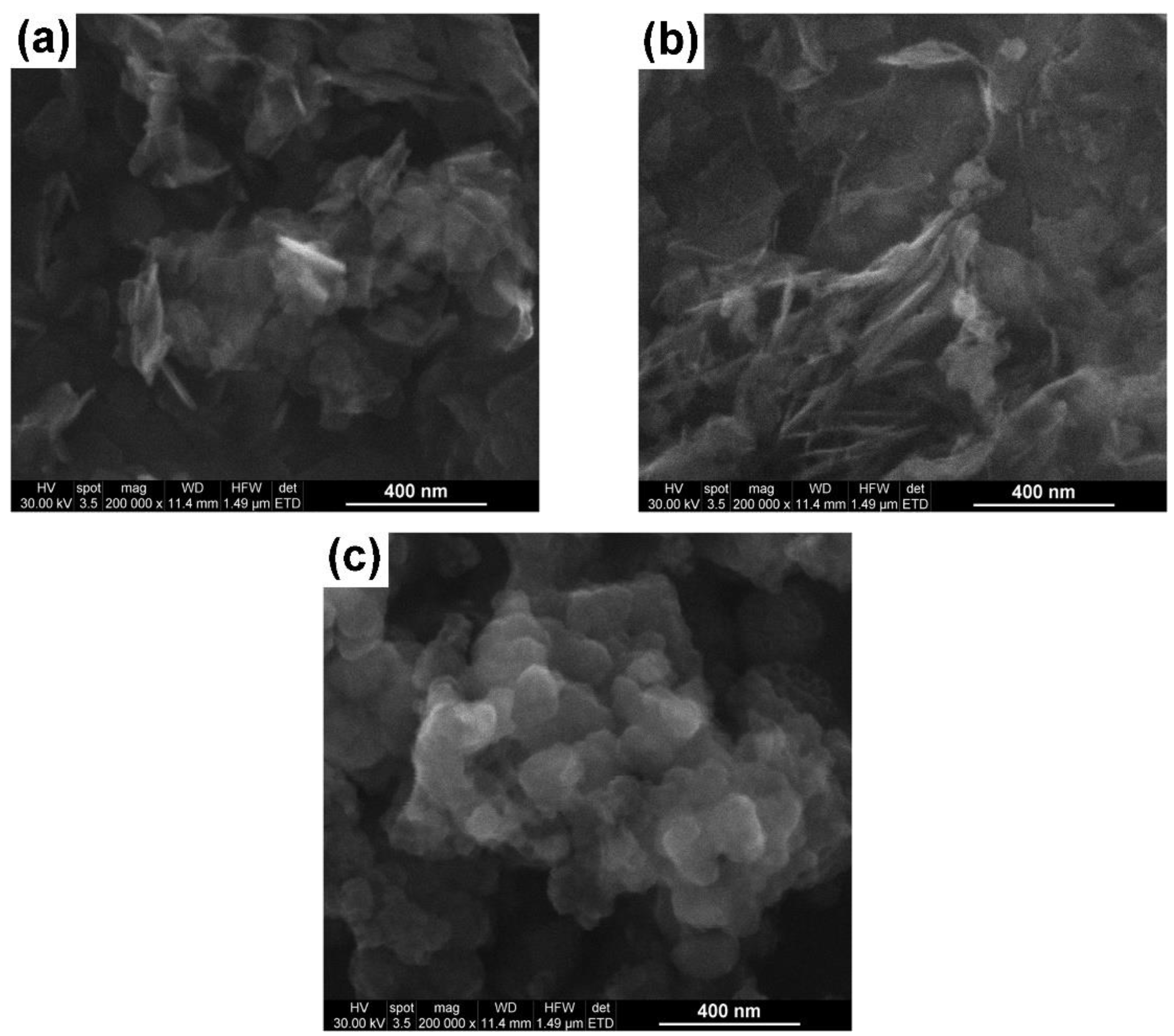
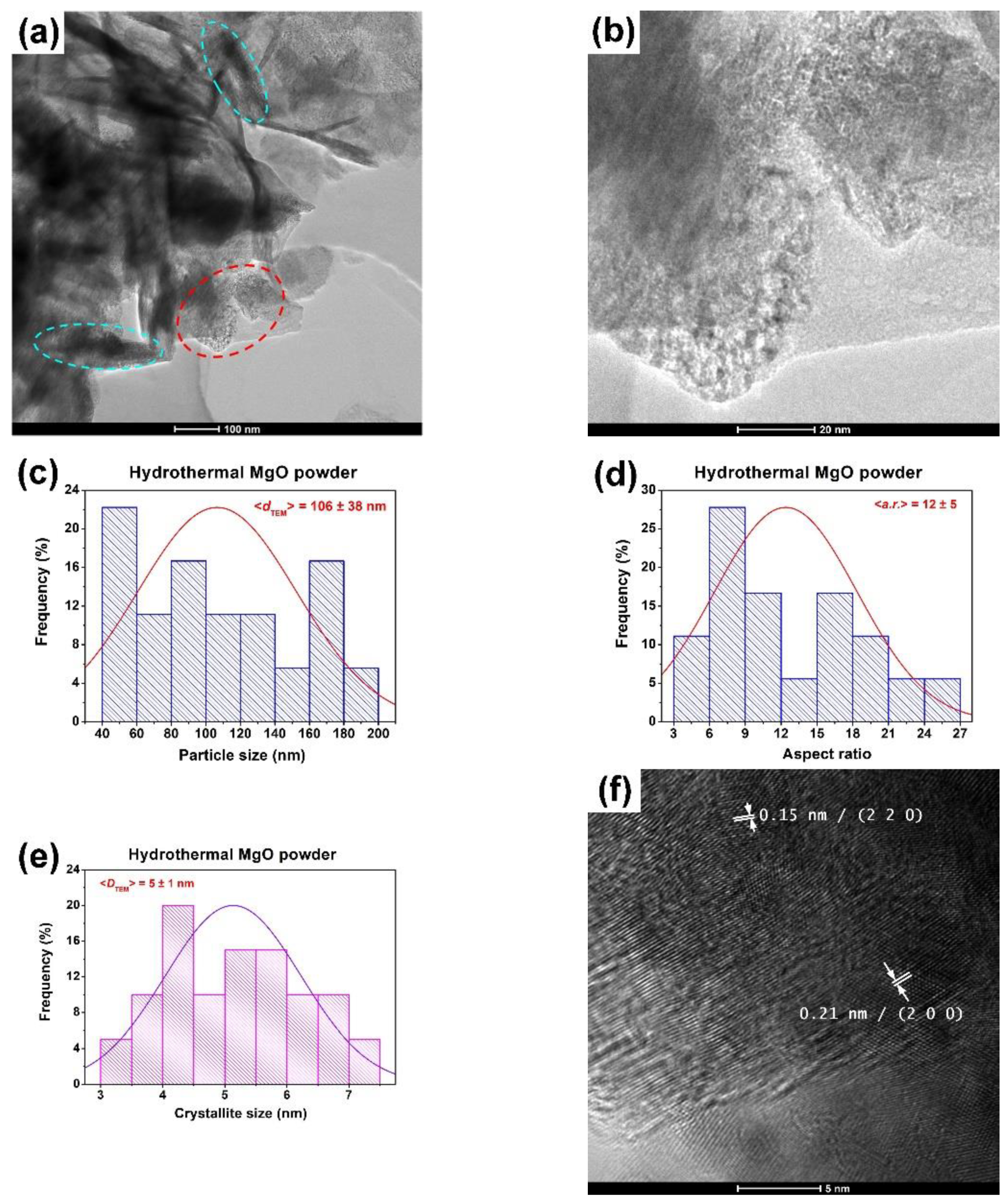
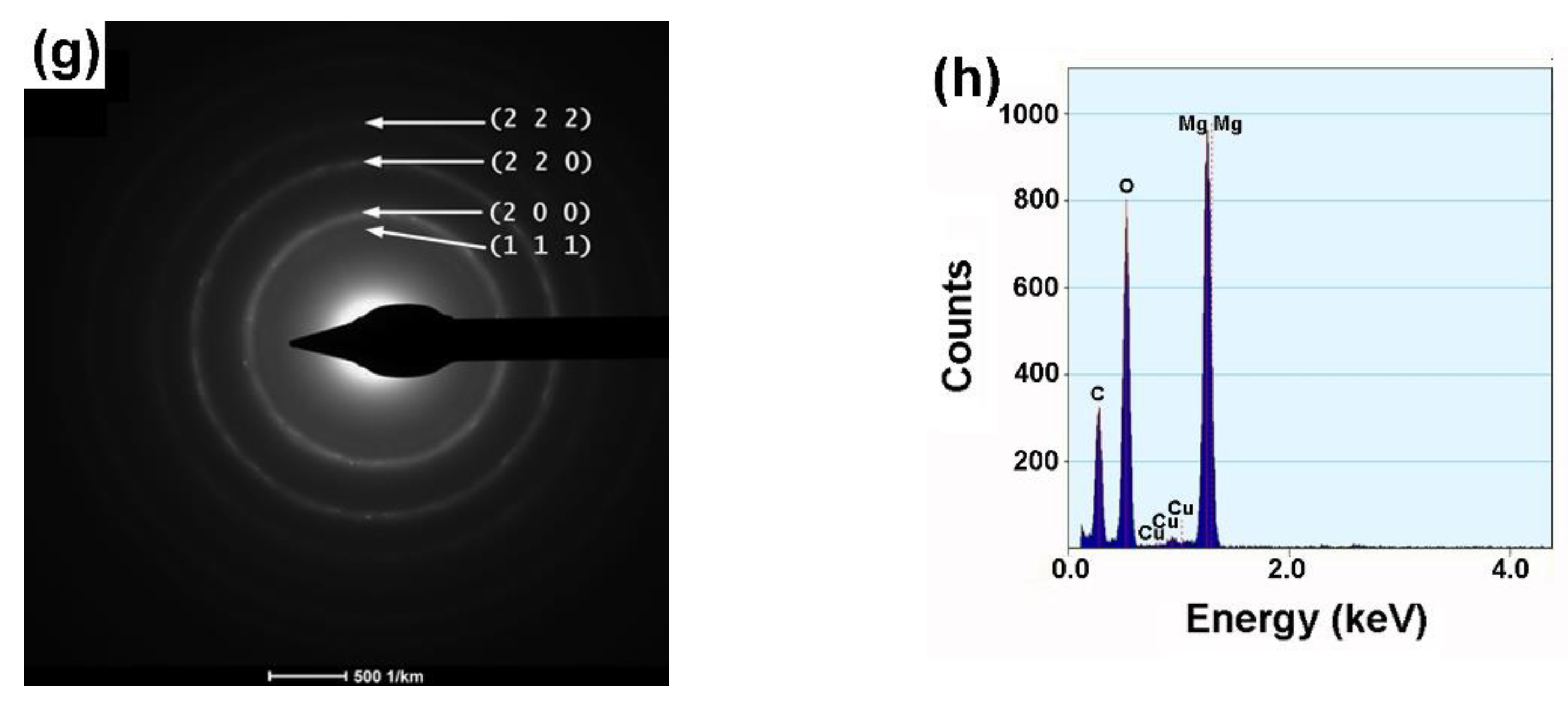
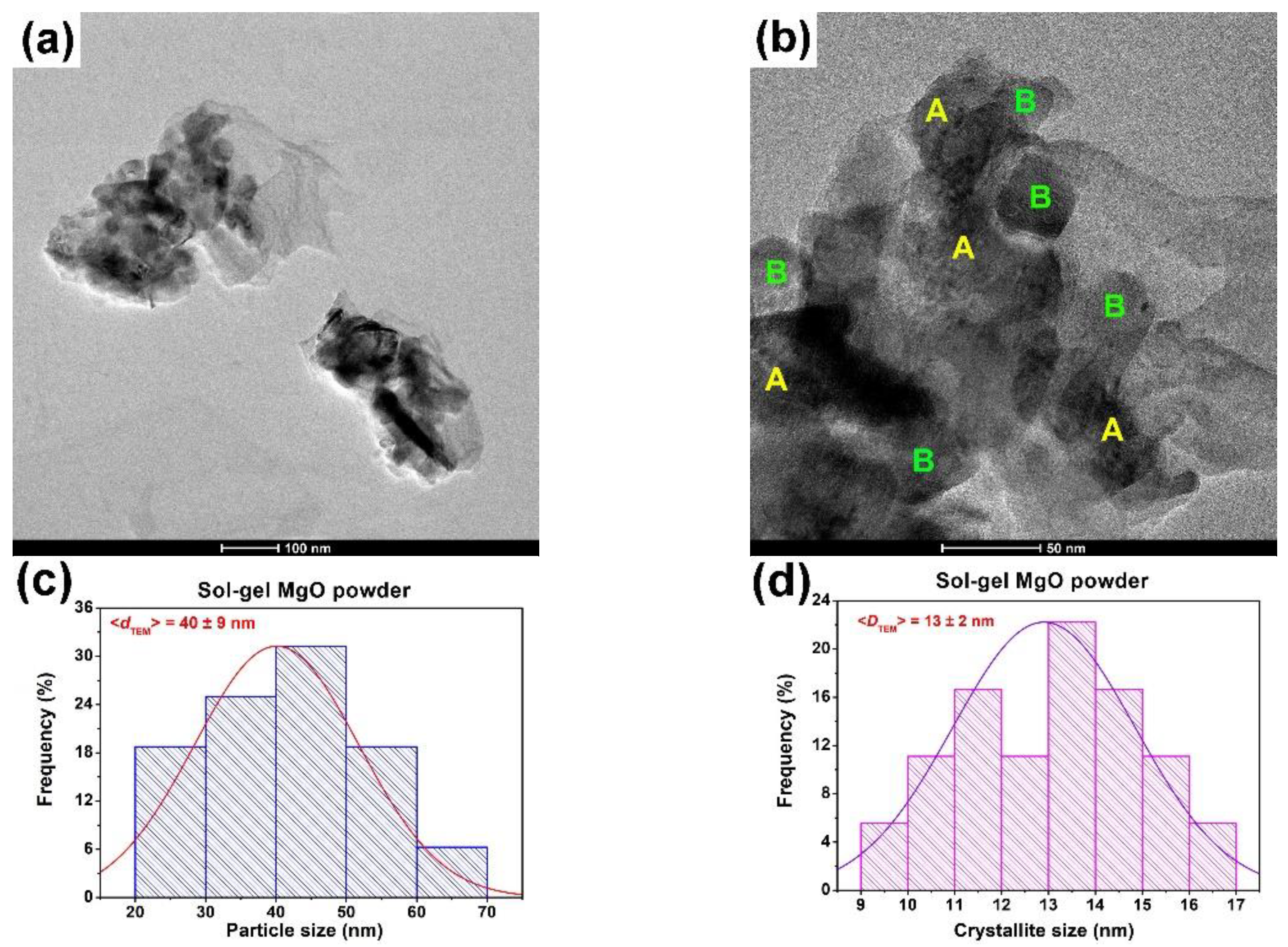
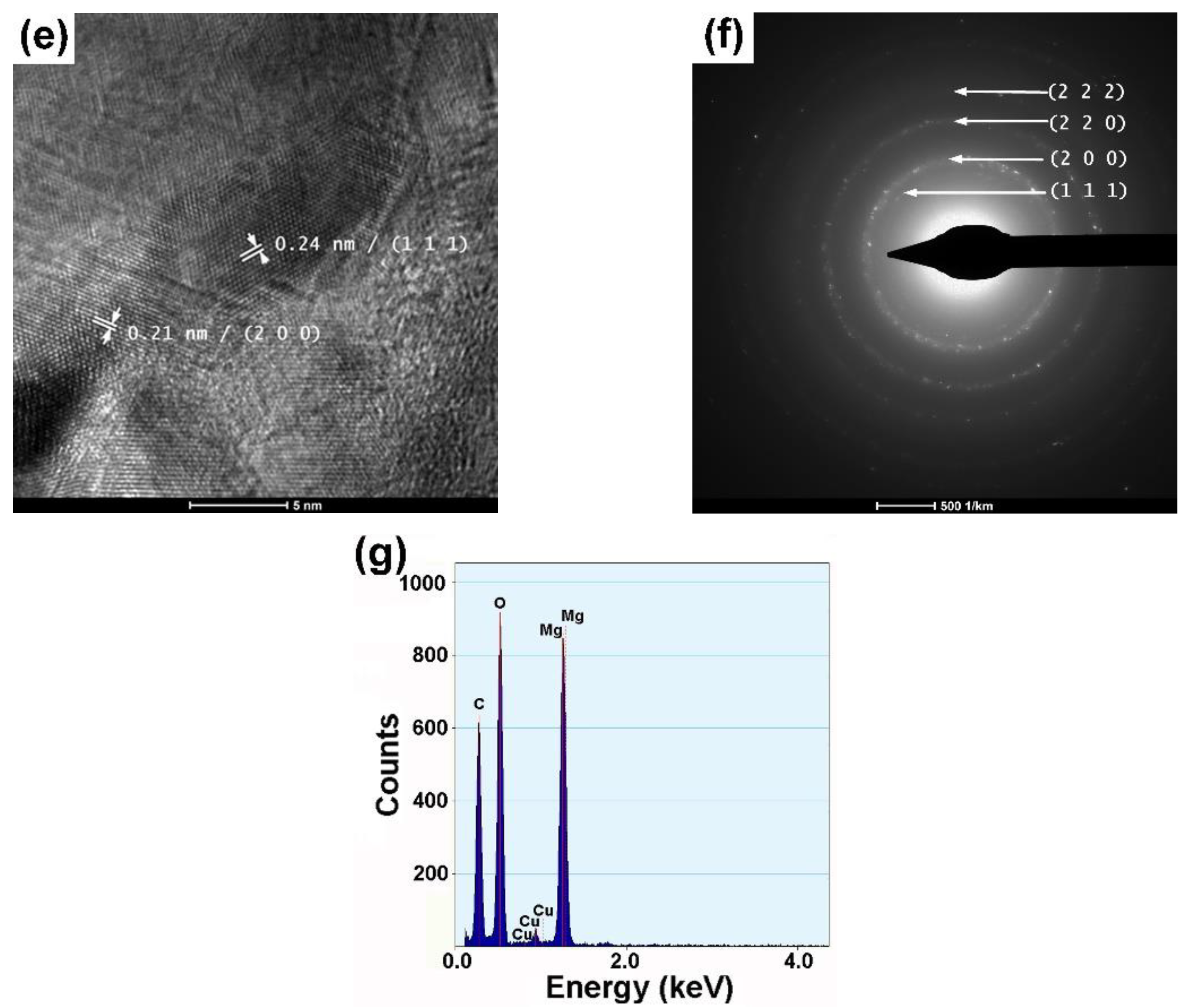
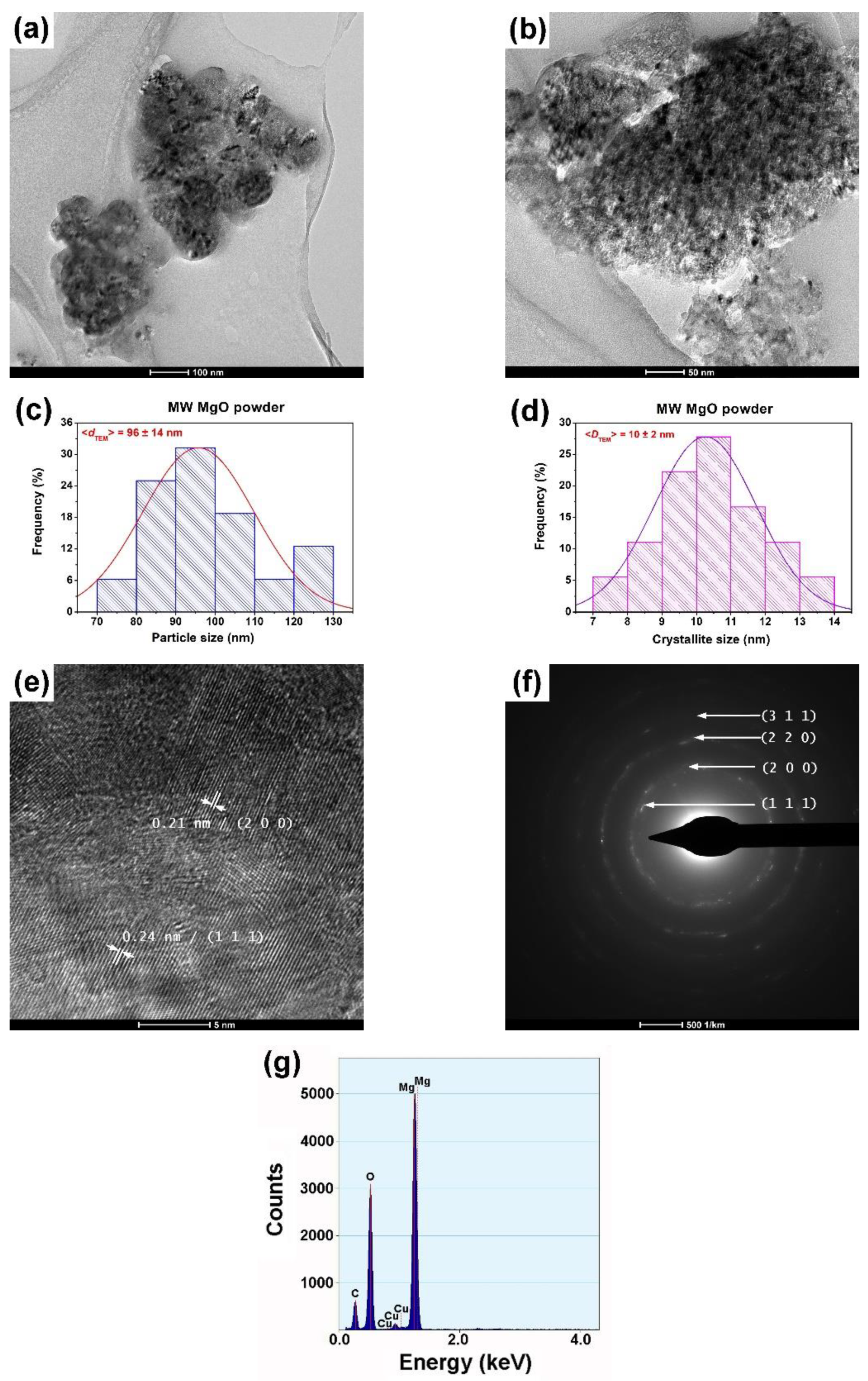

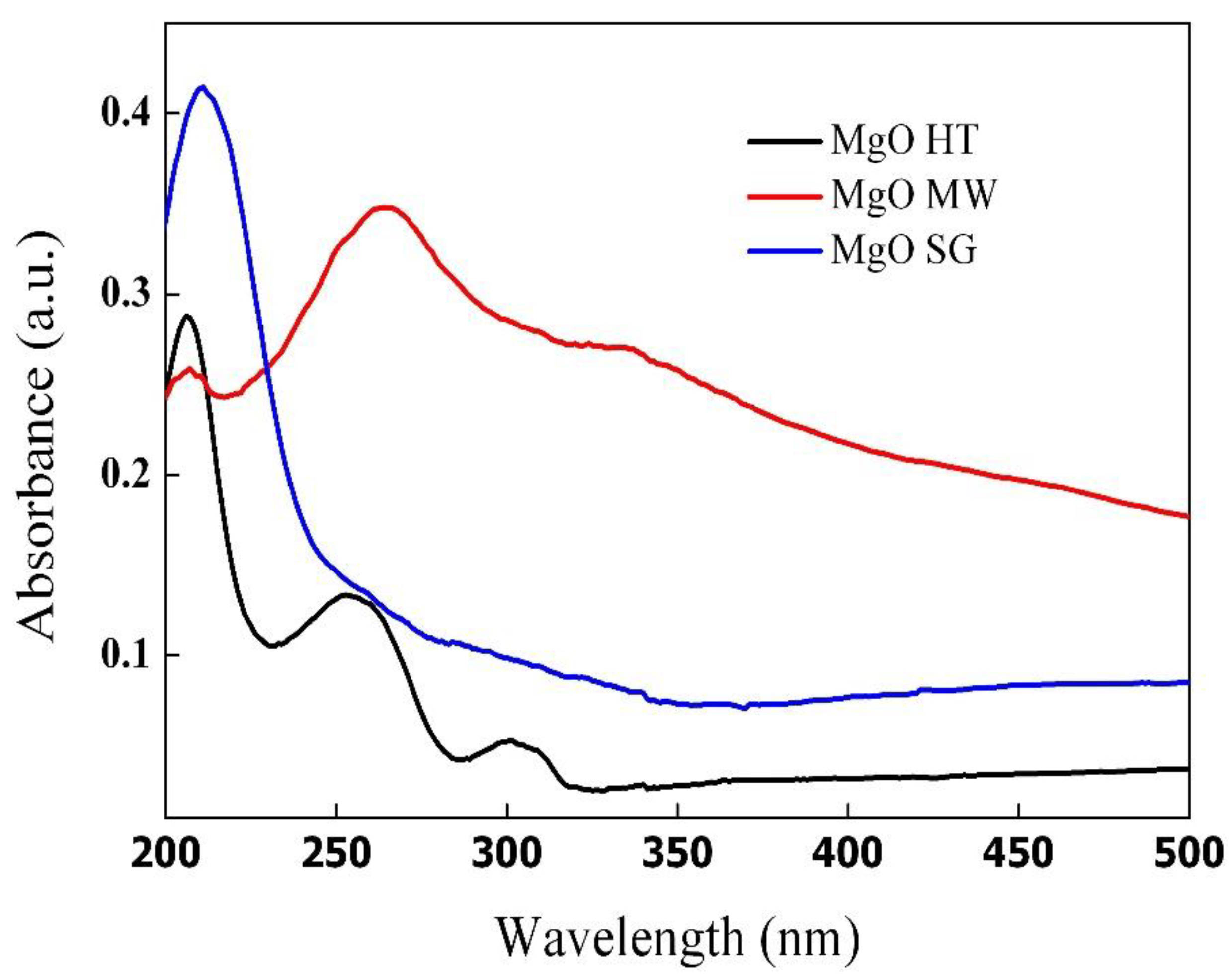


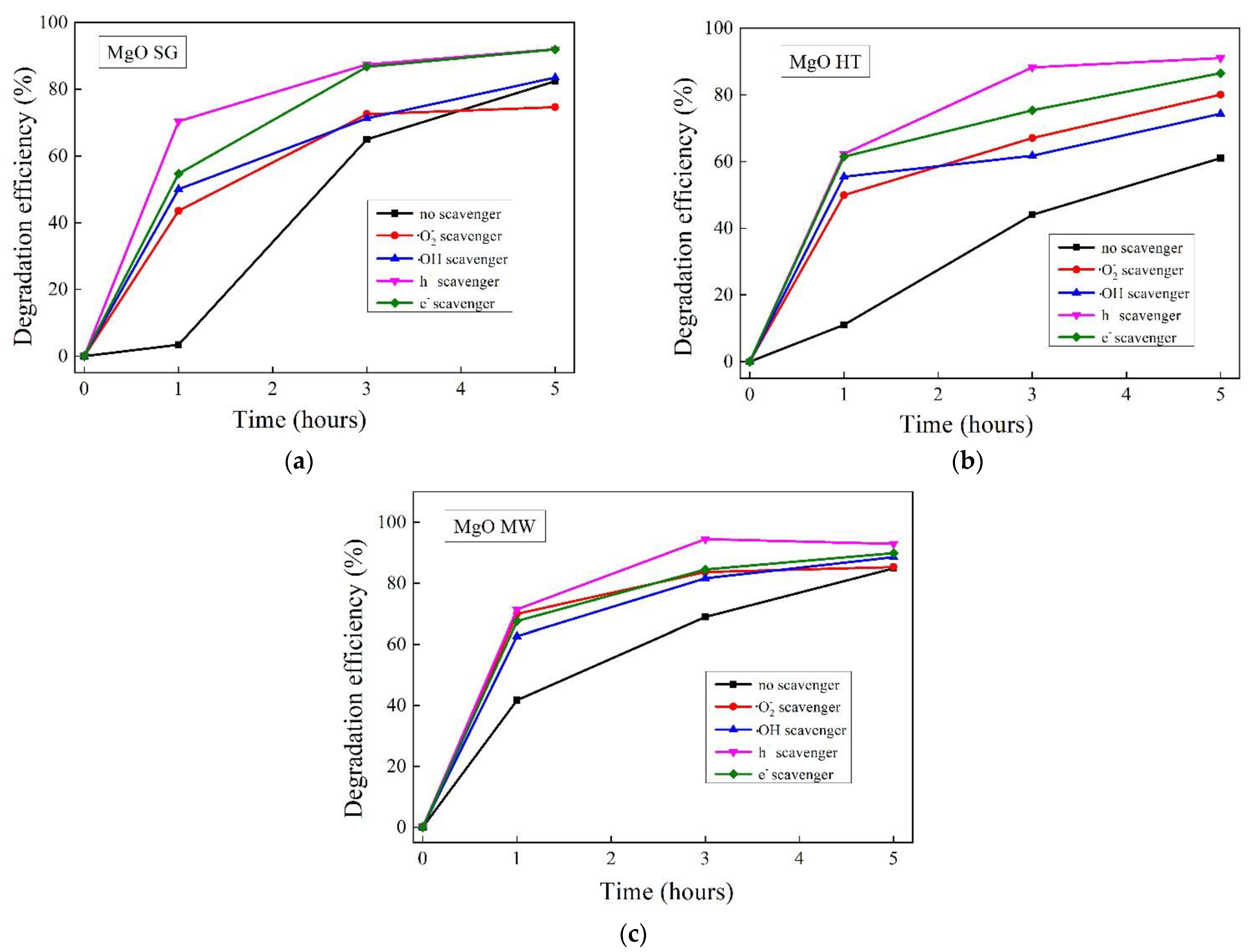

| Methods and Parameters | Precursors/Catalysts/Solvents | Thermal Treatment | Crystalline Phases and Morphologies | Ref. |
|---|---|---|---|---|
| MW–360 W, 2 min, (on/off at 30 s) | Mg(CH3COO)2 × 4H2O benzylamine | 550 °C for 5 h | MgO nanoparticles | [30] |
| MW–1 kW, 20 min (convection mode) | Mg(CH3COO)2 × 4H2O A. paniculata extract | 400 °C for 2 h | MgO nanorods | [13] |
| MW–15 min | Magnesium nitrate, NaOH, H2O | 400 °C for 4 h | MgO nanoparticles | [31] |
| MW–850 W, 15 min | Magnesium nitrate, urea, H2O | 500 °C for 2 h | MgO nanosheets | [32] |
| HT–150 °C, 3 h | MgCl2 × 6H2O, 1-Propanol, Urea (or NaOH), 2,4,6-trinitrophenol, H2O | 600 °C for 3 h | MgO nanorods (urea) and nanoparticles (NaOH) | [16] |
| HT–180 °C, 24 h | magnesium nitrate, NaOH, and H2O | 400 °C for 2 h | MgO nanoparticles | [33] |
| HT–60 °C, 3–96 h | MgCl2, Na2CO3, and H2O | 200 °C for 2 h | MgO spheroidal and flake (or) rectangular particles | [34] |
| HT–120 °C for 12 h | Mg(NO3)2 × 6H2O, CO(NH2)2), sodium dodecyl sulfate, and H2O | 400 °C for 5 h | MgO nanosheets | [35] |
| HT–180 °C for 10 h | Mg(NO3)2 × 6H2O, H2O, and ethanol | 500 °C for 3 h | MgO nanowires | [36] |
| HT–80–200 °C for 2 h | 50 nm MgO particles and H2O | 300 °C for 1 h, 450 °C for 1 h | MgO plate-like shape | [37] |
| HT–200 °C for 24 h | Mg(NO3)2 × 6H2O, urea, and H2O | 500 °C for 5 h | MgO mesoporous | [38] |
| HT–150 °C for 24 h | Mg(NO3)2 × 6H2O, NaOH, and H2O | 400 °C for 4 h | MgO flower-like shape | [31] |
| HT–130 °C for 6 h | I. (NH4)2CO3, Mg(NO3)2, and H2O II. nesquehonite, (NH4)2CO3, and H2O | 500 °C for 6 h | MgO random flakes, house-of-cards, spherical structures | [39] |
| HT–180 °C for 5 h | Mg(CH3COO)2 × 4H2O, urea, and H2O (pH 8) Mg(CH3COO)2 × 4H2O, urea, acetic acid, and H2O (pH 5–6) Mg(CH3COO)2 × 4H2O, urea, ammonia, and H2O (pH 9–10) | 500 °C for 5 h | MgO mesoporous ball-like rhombohedrons (pH 5), smaller micro-rods (pH 9), and micro-rod-like (higher pH) | [40] |
| SG | 0.1 mM Mg(NO3)2 × 6H2O, 0.1 M NaOH, and 100 mL H2O | 400 °C for 4 h | MgO + Mg(OH)2 | [31] |
| SG | Mg(NO3)2 × 6H2O and NaOH 1:2 M ratio of Mg2+ to OH- | 400 °C for 5 h | MgO spherical nanoparticles | [14] |
| SG | 8.96 wt. % Mg MeO in MeOH sol., PhMe, and MeOH hydrolysis ratio = 2 M vol. ratio PhMe: MeOH = 0.94 | 400 °C (vacuum) | MgO | [41] |
| modified thermal/SG | Mg(C2H3O2)2/Mg(NO3)2, NaOH/NH4OH, sodium dodecyl sulfate, and H2O | 400–700 °C for 2 h | MgO + MgSO4 (traces), porous, agglomerated, and uniform semi-spherical flaky shape MgO | [15] |
| SG | Mg(CH3COO)2 × 4H2O C2H2O4 × 2H2O/C4H6O6, C2H5OH, and H2O (pH 5) | 400 °C | MgO + MgC2O4 | [42] |
| 500 °C | MgO nanocrystals | |||
| SG | MgCl2 and C6H8O7 × H2O Mg2+: C6H8O7 = 1:3 T = 60 °C | 500 °C for 2 h | MgO spherical particles | [43] |
| SG | Mg(NO3)2 × 2H2O, Pluronic P123, NH4OH (28%), and H2O pH 10 and T = 60 °C | 600 °C for 2 h | MgO nanoparticles | [44] |
| SG | Mg(NO3)2 × 6H2O, NaOH, and H2O 30 min ultrasonic stirring | 400 °C for 3 h | MgO nanosphere | [32] |
| SG | Mg(NO3)2 × 6H2O, NaOH, NH4OH, and H2O molar ratio Mg2+:OH− = 1:2 | 500 °C for 4 h | MgO nanoparticles | [24] |
| SG | Mg(NO3)2 × 6H2O, NaOH, and H2O pH 12 | 500 and 800 °C for 4 h | MgO nanoparticles | [45] |
| SG | Mg(OCH3)2 and H2O 40 h at RT | 500 and 600 °C for 4 h | MgO | [46] |
| SG | Mg(OCH3)2, C2H5OH, HCl, NH4OH, and H2O pH 9 and 40 h reflux | 400, 600 and 800 °C for 2 h | MgO particles | [47] |
| Sample | Phase(s) | Lattice Parameters (Å) | Crystallite Size, DXRD (nm) | Quantitative Ratio (%) |
|---|---|---|---|---|
| MW | Periclase, MgO | 4.22569(5) | 10 | 100 |
| HT | Periclase, MgO | 4.23557(17) | 6 | 88.5 |
| Brucite, Mg(OH)2 | - | - | 7.7 | |
| Hydromagnesite, Mg5(CO3)4(OH)2 × 4H2O | - | - | 3.8 | |
| SG | Periclase, MgO | 4.21986(11) | 15 | 87.7 |
| Brucite, Mg(OH)2 | - | - | 3.3 | |
| Hydromagnesite, Mg5(CO3)4(OH)2 × 4H2O | - | - | 9 |
| Sample | SBET (m2g−1) | Vtotal (cm3g−1) | Bandgap Energy (eV) |
|---|---|---|---|
| MgO MW | 101.1 | 0.157 | 3.94 |
| MgO HT | 132.1 | 0.562 | 4.48 |
| MgO SG | 26.3 | 0.289 | 5.32 |
| Method | Phase | Band Gap (eV) | Degradation Efficiency (%) | Ref. |
|---|---|---|---|---|
| Thermal decomposition of Mg(OH)2 by the wet chemical method | Polycrystalline MgO with a cubic structure | 5.54 | 50% of methyl orange (10 mg/L) | [56] |
| Green synthesis | Cubic MgO structure | 4.17 | 81% of methylene blue (20 ppm) | [57] |
| Reflux condensation approach | Cubic MgO structure | 5.63 | 92% of methyl orange 95% of methylene blue | [1] |
| 5.67 | 96% of methyl orange 99% of methylene blue | |||
| Combustion method | Polycrystalline cubic structure of MgO nanoparticles | - | 75% of methylene blue | [4] |
| Sol–gel method | Periclase, MgO brucite, Mg(OH)2 hydromagnesite, and Mg5(CO3)4(OH)2 × 4H2O | 5.32 | 82% of methyl orange (1 × 10−5 M) | Present work |
| Hydrothermal method | Periclase, MgO brucite, Mg(OH)2 hydromagnesite, and Mg5(CO3)4(OH)2 × 4H2O | 4.48 | 61% of methyl orange (1 × 10−5 M) | |
| Microwave-assisted sol–gel method | Periclase, MgO | 3.94 | 85% of methyl orange (1 × 10−5 M) |
Disclaimer/Publisher’s Note: The statements, opinions and data contained in all publications are solely those of the individual author(s) and contributor(s) and not of MDPI and/or the editor(s). MDPI and/or the editor(s) disclaim responsibility for any injury to people or property resulting from any ideas, methods, instructions or products referred to in the content. |
© 2023 by the authors. Licensee MDPI, Basel, Switzerland. This article is an open access article distributed under the terms and conditions of the Creative Commons Attribution (CC BY) license (https://creativecommons.org/licenses/by/4.0/).
Share and Cite
Todan, L.; Predoană, L.; Petcu, G.; Preda, S.; Culiță, D.C.; Băran, A.; Trușcă, R.-D.; Surdu, V.-A.; Vasile, B.Ș.; Ianculescu, A.-C. Comparative Study of MgO Nanopowders Prepared by Different Chemical Methods. Gels 2023, 9, 624. https://doi.org/10.3390/gels9080624
Todan L, Predoană L, Petcu G, Preda S, Culiță DC, Băran A, Trușcă R-D, Surdu V-A, Vasile BȘ, Ianculescu A-C. Comparative Study of MgO Nanopowders Prepared by Different Chemical Methods. Gels. 2023; 9(8):624. https://doi.org/10.3390/gels9080624
Chicago/Turabian StyleTodan, Ligia, Luminița Predoană, Gabriela Petcu, Silviu Preda, Daniela Cristina Culiță, Adriana Băran, Roxana-Doina Trușcă, Vasile-Adrian Surdu, Bogdan Ștefan Vasile, and Adelina-Carmen Ianculescu. 2023. "Comparative Study of MgO Nanopowders Prepared by Different Chemical Methods" Gels 9, no. 8: 624. https://doi.org/10.3390/gels9080624
APA StyleTodan, L., Predoană, L., Petcu, G., Preda, S., Culiță, D. C., Băran, A., Trușcă, R.-D., Surdu, V.-A., Vasile, B. Ș., & Ianculescu, A.-C. (2023). Comparative Study of MgO Nanopowders Prepared by Different Chemical Methods. Gels, 9(8), 624. https://doi.org/10.3390/gels9080624










